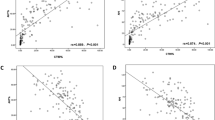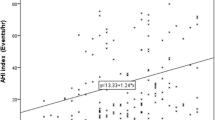Abstract
Obstructive sleep apnea/hypopnea syndrome (OSAHS) is an important and more common public health problem with increasing incidence. Polysomonography (PSG) is the gold standard test in OSAHS diagnosis. Apnea-hypopnea index (AHI) is the main parameter of PSG, which is correlated with OSAHS severity. The main complaint of OSAHS patients is daytime sleepiness and the Epworth Sleepiness Scale (ESS) used for evaluation of disease severity. The correlation of AHI with daytime sleepiness and ESS is well known. But there are many patients, which have uncorrelated daytime sleepiness with AHI. This data calls this hypothesis; Are there any other parameters which may affect daytime sleepiness. 648 patients with complaining of snoring and apnea were evaluated by polysomnography and anthropometric measurements. The cut-off value of ESS was accepted 10 as an indicator of severe daytime sleepiness. Patients were divided to groups with the aim of homogenization, according to AHI values. The patients with similar AHI values were analyzed according to their ESS scores. BMI and neck circumference were elevated in daytime sleepiness patients. The nocturnal hypoxemia markers; apnea number/index, maximum duration of apnea, at least SO2 concentration, duration of SO2 less than 90 % were much effected in the group of daytime sleepiness. Beside the fact that our research, AHI is not enough for predicting the daytime sleepiness; anthropometric measurements and the nocturnal hypoxemia markers should be evaluated.


Similar content being viewed by others
References
Carlson J, Davies R, Ehlen ZK et al (1993) Obstructive sleep apnea and blood pressure elevation : what is the relation? Blood Press 2:166–182
Dahlqvist J, Dahlqvis A, Marklund M et al (2007) Physical findings in the upper airways related to obstructive sleep apnea in men and women. Otolaryngology 127:623–630
Jons MW (1991) A new method for measuring daytime sleepiness: the Epworth sleepiness scale. Sleep 14:540–545
Karakoç Ö, Akçam T, Gerek M et al (2007) Horlama ve obstüriktif uyku apneli hastalarda epworth uykululuk skalasının güvenilirliği. KBB Forum 6:86–89
Katz I, Stradling J, Slutsky AS et al (1990) Do patients with obstructive sleep apnea have thick necks? Am Rev Respir Dis 141:1228–1231
Chau EH, Lam D, Wong J et al (2012) Obesity hypoventilation syndrome: a review of epidemiology, pathophysiology, and perioperative considerations. Anesthesiology 117:188–205
Roure N, Gomez S, Mediano O et al (2008) Daytime sleepiness and polysomnography in obstructive sleep apnea patients. Sleep Med 9:727–731
Banno K, Kryger MH (2007) Sleep apnea: clinical investigations in humans. Sleep Med 8(4):400–426
Mediano O, Barceló A, de la Peña M et al (2007) Daytime sleepiness and polysomnographic variables in sleep apnoea patients. Eur Respir J 30:110–111
Chen R, Xiong KP, Lian YX et al (2011) Daytime sleepiness and its determining factors in Chinese obstructive sleep apnea patients. Sleep Breath 15:129–135 Epub 2010 Feb 20
Zhan G, Fenik P, Pratico D, Veasey SC et al (2005) Inducible nitric oxide synthase in long-term intermittent hypoxia: hypersomnolence and brain injury. Am J Respir Crit Care Med 171:1414–1420
Zhong ZQ, Tao Y, Zhang ZP et al (2011) Relationship between excessive daytime sleepiness and oxygen saturation in obstructive sleep apnea-hypopnea syndrome. Zhonghua Yi Xue Za Zhi 4(91):40–43
Conflict of interest
There is no conflict of interest for any authors in this study.
Author information
Authors and Affiliations
Corresponding author
Rights and permissions
About this article
Cite this article
Dündar, Y., Saylam, G., Tatar, E.Ç. et al. Does AHI Value Enough for Evaluating the Obstructive Sleep Apnea Severity?. Indian J Otolaryngol Head Neck Surg 67 (Suppl 1), 16–20 (2015). https://doi.org/10.1007/s12070-014-0722-6
Received:
Accepted:
Published:
Issue Date:
DOI: https://doi.org/10.1007/s12070-014-0722-6




